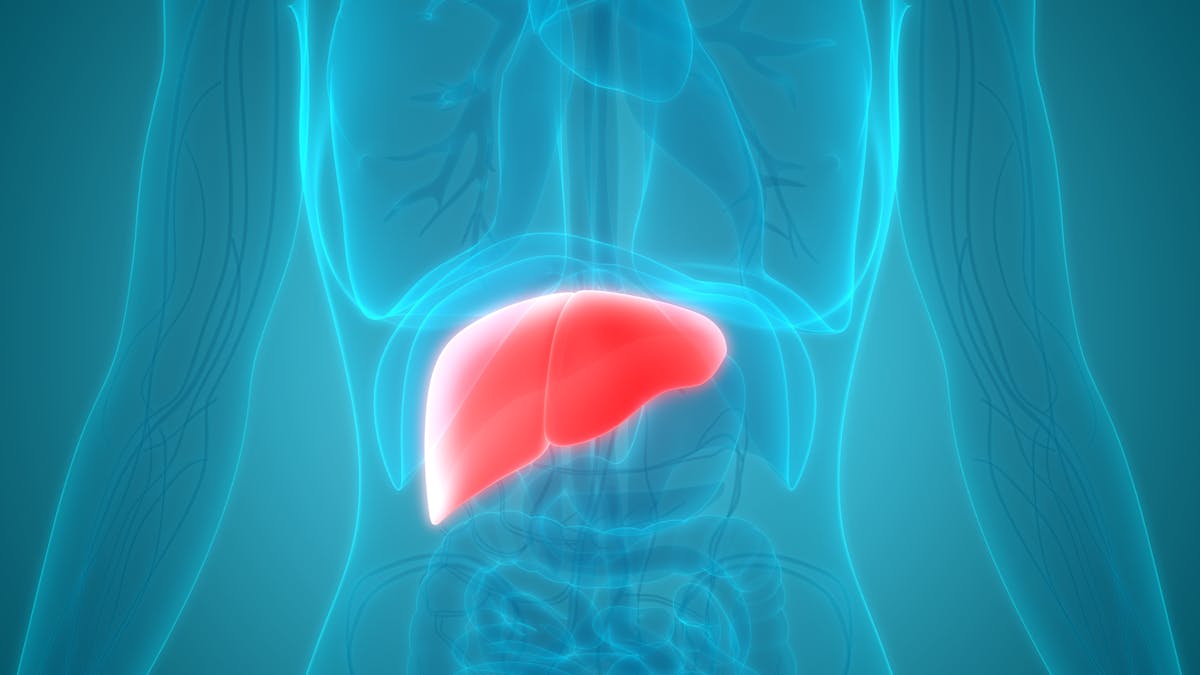Fatty liver disease and keto: 5 things to know
Although NAFLD can have dire consequences, it can potentially be improved — and in some cases even reversed — with a low-carb or keto approach. In this guide, we’ll tell you how.
Key takeaways
Low-carb or keto diets are potentially beneficial for people with NAFLD because they can:
- Reduce liver fat
- Decrease insulin levels
- Help reverse the disease process
- Suppress appetite, promote weight loss, and improve heart health markers
What is nonalcoholic fatty liver disease (NAFLD)?
In nonalcoholic fatty liver disease (NAFLD), too much fat is stored in the liver. Although everyone has a little fat in their liver, fat makes up more than 5% of the liver in people with fatty liver disease.But in 25-30% of all cases, fatty liver progresses to a more serious condition known as non-alcoholic steatohepatitis (NASH), in which the liver cells become inflamed and injured. When the liver attempts to repair these damaged cells, scar tissue forms, resulting in a condition called fibrosis.
Eventually, about 20% of NASH cases may progress to cirrhosis — end-stage, irreversible liver disease that usually results in liver failure.
While only a portion of all NAFLD cases progress to NASH and then cirrhosis, non-progressing NAFLD can still be a health problem. NAFLD has been linked to an increased risk of heart disease and type 2 diabetes.
Unfortunately, many people aren’t aware they have NAFLD because symptoms like abdominal swelling, loss of appetite, and jaundice usually don’t develop until the disease is significantly advanced.
What causes NAFLD?
Several things can contribute to the development of NAFLD. These include:
- Excess energy intake: Eating more calories than needed may lead to excess fat accumulation in the liver — and research suggests this can happen no matter what type of food is over consumed.
- Too many refined carbs: Consuming more refined carbohydrates than your body is able to handle can drive liver fat storage via a process known as de novo lipogenesis (literally “making new fat”).This typically happens when both carb and calorie intake are high.
In one study, when overweight adults ate 1,000 extra calories as refined carbs, they experienced a 27% increase in liver fat after just three weeks. - Too much sugar: When it comes to excess carbs, sweets and sugar-sweetened beverages may be especially problematic. These items are high in fructose, which has been shown to increase liver fat when consumed in large amounts.Some researchers believe that high fructose intake is a major contributor to NAFLD.
- Saturated fat: Overeating saturated fat can also increase the likelihood of developing fatty liver. But most studies that demonstrate saturated fat as a contributor to fatty liver involve overeating calories in a mixed high fat, high carb, high calorie diet.As we explain later in this guide, low-carb diets that promote weight loss improve fatty liver, even when they contain ample amounts of saturated fat. Therefore, whether we are discussing carbs or fats, the underlying dietary matrix appears to have a greater effect that the macronutrient under discussion.
- Sedentary lifestyle: Observational research suggests that spending too much time sitting rather than moving may promote excess liver fat storage.However, this is hard to differentiate from other potential contributing lifestyle factors.
Risk factors for NAFLD
Not everyone who consumes a lot of refined carbs and gets little exercise will end up developing NAFLD. So who is most likely to get it?
Here are some things that increase the likelihood of developing NAFLD:
- Insulin resistance: People with insulin-resistant conditions like type 2 diabetes and metabolic syndrome are at higher risk for NAFLD. Although the exact mechanism isn’t completely understood, insulin resistance and high insulin levels are known to promote excessive storage of liver fat.
- Carrying too much weight around the middle: Because it’s so strongly linked to high insulin levels, large waist size places people at increased risk for NAFLD, even if their BMI is in the “normal” range.
- Genetics: Some people are more likely to develop NAFLD because they’ve inherited certain gene variants that increase their risk for the disease. However, further research in this area is needed.
How to know if you have NAFLD
NAFLD is diagnosed by lab tests, a liver ultrasound or a CT scan, and sometimes a liver biopsy. With blood testing, certain liver enzymes are elevated, especially GGT, ALT, and AST. Triglycerides and insulin levels also tend to be high. An ultrasound or CT scan will typically show excess fat in the liver.
Using a formula that calculates the combined effects of triglycerides, GGT, waist size and BMI, the Fatty Liver Index has been shown to help predict the likelihood that someone has NAFLD. However, in at least one study, waist size alone was found to similarly predict this risk.
If you already have a diagnosis of NAFLD and want to know more about how far it has progressed, some gastroenterologists are using a special kind of ultrasound called FibroScan. This is less invasive than liver biopsy and can be used to determine whether fibrosis has occurred and to what extent. It can also be used to track progression or regression of NAFLD over time.
If you think you may have NAFLD, follow up with your doctor for further testing.
Why a low-carb or keto diet can improve NAFLD
Because many people with NAFLD are overweight, they often receive recommendations to eat low-calorie or low-fat diets. However, that may not be the best choice for many people. While many diets that lead to weight loss can improve fatty liver, evidence suggests low-carb diets may be more effective than low-fat.
Low-carb and keto diets can help people with NAFLD because they:
- Decrease liver fat: Since eating too many carbs can increase liver fat storage, it makes sense that cutting back on carbs can have the opposite effect. And studies have confirmed that this is exactly what occurs.
In an eight-week randomized controlled trial (RCT) of 106 people with NAFLD, those who ate a low-carb diet had greater reductions in liver fat and less abdominal fat than those who ate a low-fat diet.Several smaller trials have also shown a decrease in liver fat with a low-carb approach.And one RCT reported a keto diet and a 5:2 fasting regimen were superior to standard advice from a liver specialist in reducing liver steatosis. - Reduce insulin levels and insulin resistance: A very-low-carb diet can dramatically improve insulin sensitivity in people with NAFLD — and often very quickly.
In one study, people with NAFLD who ate a keto diet for six days had a 58% decrease in insulin resistance and a 53% decrease in insulin levels. According to the researchers, the lower insulin levels allowed liver fat to be broken down and converted into ketones.Another study reported almost 50% improvement in liver function tests and markers of insulin resistance in patients with NAFLD who followed a low-carb diet. - May help reverse the disease process: Several small studies have shown that in addition to preventing the progression of NAFLD, low-carb eating may actually reverse the disease.
In a 12-week study of people with metabolic syndrome and NAFLD who followed a Spanish Mediterranean ketogenic diet, 13 of 14 people had a decrease in liver fat levels, and three had a complete resolution of NAFLD.In another small trial, patients with NAFLD ate a diet that limited carbs to 20 grams per day for six months. By the end of the study, fatty liver, inflammation, and fibrosis had improved in four of the five patients.And in the analysis of one-year data from Virta Health’s large ongoing study in people with type 2 diabetes, most participants with NAFLD who followed a very-low-carb diet had reductions in liver fat and fibrosis scores. - Suppress appetite, promote abdominal fat loss, and improve heart health markers: Ketogenic diets have been shown to help reduce appetite in several studies, including a meta-analysis of RCTs, which is considered the strongest, highest-quality evidence.In several trials, people with NAFLD who followed a keto or low-carb diet ended up eating less and losing abdominal fat without intentionally restricting calories.Other benefits of low-carb eating include reductions in heart disease risks factors, such as lower blood triglycerides, blood sugar, and blood pressure.
Getting started with low carb or keto for NAFLD
After getting the OK from your doctor, you can learn the basics of low-carb eating in our keto and low-carb diet guides.
Although a very-low-carb approach seems to produce the most dramatic reduction in liver fat, if you’d rather reduce carbs more gradually, read Eating better: Six steps down the carb mountain to get started.
In addition to paying attention to carb intake, make sure to get enough protein. Higher protein intake has been found to reduce liver fat in people with NAFLD, as well as those with type 2 diabetes.
You may also want to try our higher satiety eating plan to fine tune your low carb diet for even greater healthy weight loss success.
Other lifestyle changes that may improve NAFLD
Besides eating low carb, a few other changes might also be helpful:
- Exercise regularly: Being more physically active can help reduce insulin resistance and liver fat. Which type of exercise is best? In a review of 12 trials, performing either aerobic exercise or resistance training for 40-45 minutes three times a week was found to be beneficial for NAFLD.So choose the type of exercise you prefer and that feels sustainable. Or better yet, aim for a combination of both, if you can.
- Include fatty fish in your diet: Try to eat salmon, sardines, mackerel, or anchovies at least twice a week. These fish are high in omega-3 fats, which have been shown to reduce liver fat, GGT, and triglycerides in people with NAFLD.
- Consider turmeric or curcumin: You may know turmeric as the bright-yellow, pungent spice used in Indian and Asian curries and other dishes. Studies suggest that turmeric or its active component curcumin may help lower liver enzymes in those with NAFLD.Curcumin has also been shown to produce slight weight loss and reduce waist size in people who are overweight or have metabolic syndrome.Try increasing the amount of turmeric in curries and other recipes that call for it, like our Keto coconut curry chicken or Pork tenderloin with curry sauce. Another option is to take a supplement containing 500 mg of curcumin.
Note: If you take blood thinners, do not take curcumin or turmeric before speaking with your doctor or pharmacist.
Medications for NAFLD
While diet and exercise are the first and most important interventions for NAFLD, there are some pharmacologic options as well.
- Vitamin E: What is the rationale for using vitamin E to treat fatty liver? Because oxidative stress plays a role in NAFLD, a powerful antioxidant like vitamin E has the potential to modify the underlying disease process. Although research over the years has been mixed about how helpful it is, a recent meta-analysis of RCTs suggests that high-dose vitamin E does improve both liver enzymes and the features of NAFLD seen on liver biopsy, at least in adults.Why do we consider vitamin E a medication and not simply a supplement? When used at the high doses necessary for treating NAFLD, vitamin E carries many risks that merit careful consideration: hemorrhagic stroke, prostate cancer, and all-cause mortality.
- Pioglitazone: This diabetes drug has also been extensively studied as a treatment for NAFLD, and has been shown to improve disease activity, reduce the progression to liver fibrosis, and also improve multiple cardiometabolic risk factors.If you have fatty liver and type 2 diabetes that isn’t well-controlled on your current diabetic regimen, pioglitazone may be a reasonable option that can do double-duty. As with any other medication, talk to your doctor about the potential side effects, such as weight gain.
- GLP-1 receptor agonists: This class of diabetes medication has been in the news lately due to semaglutide’s potency as a weight loss drug, but the class as a whole has also been studied for NAFLD. GLP-1 receptor agonists have been shown to improve liver enzymes, reduce fatty infiltration of liver cells, and reverse liver fibrosis.Because the medications in this class lower blood sugar and cause weight loss, they may be a reasonable choice as add-on therapy for people with type 2 diabetes and fatty liver.
Summary
Fatty liver disease occurs due to a combination of lifestyle and genetic factors. If allowed to progress from simple fatty liver, it can sometimes lead to more serious liver disease.
The good news is that a low-carb or keto diet can lead to a dramatic loss of liver fat and may potentially reverse the disease. The time to start is now, so you can begin living your healthiest, best life.

Try our keto & low-carb meal plans for free!
Our popular meal plans are customizable and include shopping lists and nutritional information. Now you can try them out one month for free! Sign up for Diet Doctor Plus today to make your low-carb journey even more simple, fun and delicious. The full Diet Doctor experience also includes exclusive videos, support, programs and more.
Start free trial



